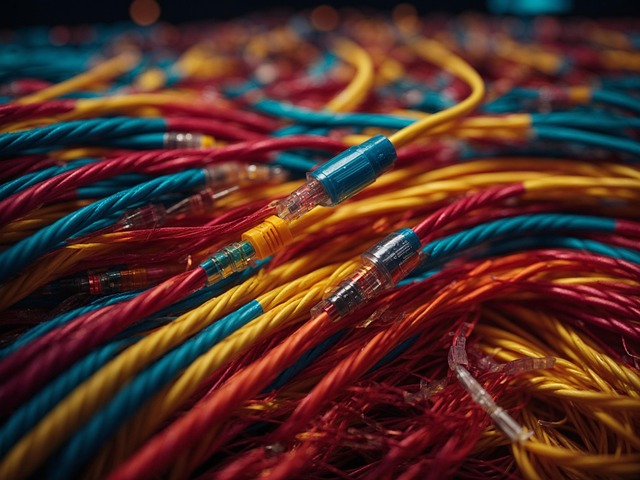Understanding Ethernet Physical Layer Voltage Levels: A Practical Guide
Author: Jameson Richman Expert
Published On: 2025-11-09
Prepared by Jameson Richman and our team of experts with over a decade of experience in cryptocurrency and digital asset analysis. Learn more about us.
Ethernet physical layer voltage levels define how data is represented, transmitted, and measured on copper cables and influence signal integrity, interoperability, and compliance testing. This comprehensive guide explains the voltage characteristics of common Ethernet standards (10BASE‑T, 100BASE‑TX, 1000BASE‑T, and beyond), how magnetics and PoE affect voltages, how to measure and troubleshoot voltages correctly, and practical design and test tips for engineers and technicians.

What this article covers
- Core concepts: differential vs. common‑mode, amplitude, center taps, and cable impedance
- Voltage characteristics for popular Ethernet standards and what “typical” means
- How magnetics (transformers) and AC coupling change measured voltages
- Power over Ethernet (PoE) interaction with PHY voltages
- How to measure Ethernet voltages safely and accurately
- Design tips, compliance considerations, and further reading
Ethernet physical layer basics: signaling and voltage terminology
Before diving into numeric examples, it helps to define common terms used when discussing Ethernet physical layer voltage levels:
- Differential voltage (Vdiff) — the voltage difference between the two wires of a twisted pair. Ethernet signaling is primarily differential to improve noise immunity.
- Common‑mode voltage (Vcm) — the average voltage of the two wires relative to a reference (usually chassis or earth). Common‑mode is important for magnetics, isolation, and EMC behavior.
- Peak-to-peak voltage (Vpp) — the maximum voltage swing (max to min). Differential Vpp is often quoted for line signaling.
- Characteristic impedance — typical twisted pair impedance is ~100 Ω differential. PHY drivers are designed to work against this load.
- AC coupling and magnetics — the cable is connected to the PHY through isolation transformers (magnetics) and AC coupling; this blocks DC and adjusts common‑mode while passing the differential signal.
Understanding these concepts helps you interpret measurements and design decisions: a PHY driver may only source a small differential amplitude, but after cabling, reflections, and receiver sensitivity, the system achieves reliable signaling.
Voltage characteristics by Ethernet standard (what to expect)
The IEEE 802.3 family defines signaling schemes for different speeds. Each speed uses a different line code, and therefore different voltage patterns. Below are typical characteristics and practical notes on each common copper Ethernet variant.
10BASE‑T (10 Mbps)
10BASE‑T uses Manchester encoding and a bipolar signaling scheme across a twisted pair. Modern 10BASE‑T PHYs provide a differential signal that is magnetically coupled to the cable. Key points:
- Signaling is baseband, with return‑to‑zero transitions (Manchester) that encode both clock and data.
- PHY transceivers are designed to drive the pair into a 100 Ω differential load through magnetics; the effective line waveform is AC‑coupled.
- Typical differential amplitude on the cable is in the low volt (order of volts peak‑to‑peak) range; exact values are specified in IEEE 802.3 for compliance testing.
For precise test numbers, refer to the IEEE 802.3 standard and the technical description on the 10BASE‑T Wikipedia page and the Ethernet overview on Wikipedia. These resources offer grounding in the line code and physical mechanisms.
100BASE‑TX (Fast Ethernet)
100BASE‑TX uses MLT‑3 encoding on a pair (with a 125 MHz symbol rate) and transmits over two pairs (one for transmit, one for receive on half‑duplex legacy wiring; modern switches use auto MDI/MDX). Important notes:
- MLT‑3 is a three‑level code with transitions between +1, 0, and −1 states. This reduces bandwidth relative to simpler NRZ encodings.
- Typical differential voltage levels are lower than early 10BASE‑T line amplitudes; PHYs aim for specific levels at the cable to meet the receiver sensitivity and the channel model in the IEEE standard.
- Because of magnetics and AC coupling, a DC measurement with a DMM will read near zero; differential and common‑mode measurements require appropriate equipment.
See the 100BASE‑TX Wikipedia article for a high‑level technical description; the IEEE 802.3 specs contain exact electrical masks and test conditions for certified equipment.
1000BASE‑T (Gigabit Ethernet)
1000BASE‑T is more complex: it uses four pairs simultaneously, full‑duplex on each pair, and 5‑level PAM (PAM‑5) with echo cancellation and hybrid circuits. Key voltage considerations:
- Each pair carries simultaneous transmit and receive signals; the PHY relies on echo cancellation and adaptive equalization to separate them.
- Signals use multiple discrete voltage levels (for PAM‑5), commonly expressed as quintet steps like −2, −1, 0, +1, +2. The absolute voltages are small (on the order of < 2.5 V peak‑to‑peak differential) and are carefully defined in IEEE 802.3 for channel modeling.
- Because of the echo cancellation and transformer's behavior, measuring the transmit amplitude requires a differential probe and knowledge of where the transformer's center tap and receiver sense points are located.
For engineering accuracy and compliance, consult the authoritative IEEE 802.3 standard and vendor PHY datasheets.
10GBASE‑T and higher
10GBASE‑T uses advanced PAM‑16 signaling and very aggressive DSP/equalization. Voltage amplitudes remain small and precisely controlled; noise budgets, cable attenuation, and crosstalk become dominant design drivers.
Practical implication: as speed increases, the emphasis shifts from raw voltage amplitude to spectral shaping, timing recovery, and sophisticated digital signal processing to maintain bit error rates across realistic cabling.

How magnetics, AC coupling, and connectors change measured voltages
When you probe an Ethernet cable, you rarely see the raw PHY transmitter voltage: magnetics and coupling isolate DC and common‑mode components and help shape the signal for safety and EMI. Key factors:
- Isolation transformers (magnetics) provide galvanic isolation and set the common‑mode coupling. They block DC and shift common‑mode to safe levels; the center tap used for PoE may carry DC when PoE is present.
- AC coupling ensures DC offsets from PHYs don’t appear on the cable. When measuring with DC‑coupled instruments, you may see near‑zero DC on the cable even though PHY transceivers have internal reference voltages.
- Connector/contact resistance and impedance mismatches can change apparent amplitudes, especially near the ends of long cables where reflections matter.
Therefore, voltage measurements must account for the location (PHY side vs. cable side), the presence of magnetics, and any PoE DC on center taps or spare pairs.
Power over Ethernet (PoE): how 48 V DC interacts with PHY voltages
PoE (IEEE 802.3af/at/bt) places DC power on pairs of an Ethernet cable, typically in the 44–57 V range (nominally ≈48 V). This has critical implications for the physical layer:
- PoE injects DC on pair center taps or spare pairs; magnetics and PHYs are designed to block DC from the transceiver, but care is needed when probing and designing circuits.
- When measuring, use isolation and observe that a DMM across a pair might show the PoE DC if probing the center taps or unused conductors; the differential data signaling remains AC‑coupled and is superimposed on the DC power path.
- PoE introduces heat and may affect cable attenuation and connector contact resistance; ensure designs account for thermal and EMC impacts.
PoE’s DC must be respected during test and troubleshooting: always follow safety procedures, and if you need to inject or remove PoE, do so with purpose‑built equipment.
How to measure Ethernet voltages safely and accurately
Measuring Ethernet physical layer voltage levels requires the right tools and approaches to avoid misleading results or damaging equipment.
Essential tools
- 2‑channel or 4‑channel oscilloscope with a true differential probe (or two matched probes and subtraction capability).
- High‑bandwidth differential probe (for gigabit and faster links, use probes rated for 100+ MHz or more, ideally matching the symbol bandwidth).
- Network cable testers and Ethernet PHY diagnostic tools for link status, error counts, and PHY‑level logs.
- DC multimeter for measuring PoE voltages on center taps (with isolation and PoE‑capable clamps).
Measurement tips
- Always use a differential probe when measuring across a twisted pair. Single‑ended scope probes will reference chassis ground and can short center taps or damage isolation magnetics.
- Measure near the cable midpoint and near the connector to understand reflections and insertion loss—signal amplitudes differ along the link due to attenuation and reflections.
- AC‑coupled vs. DC‑coupled measurements: an oscilloscope can be AC‑coupled to remove DC offsets, but you lose true DC common‑mode info important for PoE assessments.
- Use proper termination or measure across the cable with 100 Ω differential termination to mimic the receiver load and obtain accurate amplitude readings.
- Capture an eye diagram to check timing and amplitude margins. The eye height and width are practical indicators of signal integrity beyond simple Vpp measurements.
Common measurement mistakes
- Using single‑ended probes and seeing “mystery voltages” caused by common‑mode coupling to chassis ground.
- Failing to consider magnetics: measuring on the PHY side vs. the cable side yields different DC behavior.
- Disconnecting PoE with live equipment—this can reset devices or cause unexpected behavior; use PoE testers to safely interact with powered links.

Design and troubleshooting advice for PHY voltage behavior
Engineers designing PHY interfaces or troubleshooting link problems should consider the following practical tips and checklists for reliable operation:
Design checklist
- Choose a PHY with documented compliance to IEEE 802.3 for the target speed. Datasheets often include spectral masks and output amplitude expectations.
- Select appropriate magnetics (isolation transformers) that meet insertion loss and common‑mode rejection requirements for the cable lengths and speeds you expect.
- Design the PCB with controlled impedance (100 Ω differential traces) and proper connector placement to minimize reflections.
- Include ESD protection and surge suppression on the magnetics/connector to protect against transients on the cable.
- Plan for PoE if needed—select magnetics and center‑tap arrangement that support the required PoE standard and current.
Troubleshooting checklist
- Verify link negotiation and duplex settings via software tools (NIC or switch logs) before jumping to physical measurements.
- Use a cable tester to confirm pair continuity, wiremap, and length. Bad pairs or split pairs can produce strange amplitude and timing behavior.
- Inspect magnetics and connectors: damaged transformers or poor RJ45 contacts can reduce differential amplitude or cause excessive common‑mode noise.
- Measure differential Vpp and eye diagram with a differential probe. Compare against known good ports or PHY reference waveforms.
- Look for excessive packet errors or CRCs—these often indicate reduced SNR caused by small voltage margins, crosstalk, or cable damage.
Standards, masks, and where to find authoritative specs
When you need exact numbers for voltage levels, masks, and compliance tests, turn to standards and vendor documentation:
- IEEE 802.3 — the definitive standard for Ethernet electrical characteristics, encoding schemes, and compliance tests (IEEE 802.3 standard).
- PHY vendor datasheets and application notes — provide measured output waveforms, recommended magnetics, and test setups (look for application notes from PHY vendors like Microchip, Broadcom, or Texas Instruments).
- Reference educational material and overviews on Wikipedia and university course notes for conceptual explanations.
These resources will give you the exact amplitude masks, spectral requirements, and protocol conformance tests required to certify equipment or validate a design.
Practical examples: interpreting real measurements
Here are three practical scenarios and how to interpret voltage behavior:
Example 1 — Low differential amplitude on a gigabit link
Symptom: Link is up but CRC errors are high; differential Vpp measured with a differential probe is lower than expected.
Troubleshooting steps:
- Check for cable damage, long runs, or poor RJ45 terminations causing attenuation and reflections.
- Verify magnetics are specified for gigabit operation—transformers with higher insertion loss reduce amplitude and SNR.
- Examine cross talk from adjacent cables (nearby high‑speed lines) and improve cable routing or shielding if needed.
- Confirm PHY firmware/autonegotiation settings and that auto‑MDI/MDIX is functioning correctly.
Example 2 — Unexpected DC on a pair when PoE is supposed to be off
Symptom: Multimeter shows ~48 V on pair center taps despite PoE configuration indicating off.
Possible causes and checks:
- Check if the PD (powered device) is actually sourcing power or if the switch has PoE enabled for that port.
- Inspect for wiring faults where DC is coupled through damaged magnetics or incorrect jack wiring.
- Measure with the device disconnected to ensure you’re not measuring a feedthrough path from an external supply.
Example 3 — Strange common‑mode spikes and EMI complaints
Symptom: Nearby sensitive equipment experiences interference when Ethernet traffic is heavy.
Mitigation steps:
- Improve common‑mode choke design in magnetics and add common‑mode filtering on PCB if necessary.
- Ensure cable routing provides physical separation from vulnerable analog circuits.
- Validate that the PHY’s common‑mode range and magnetics meet the EMC test configuration in IEEE 802.3 and regional EMC standards.

Advanced considerations: echo cancellation, adaptive equalization, and signaling masks
Higher‑speed Ethernet PHYs rely heavily on DSP techniques:
- Echo cancellation: Required for full‑duplex simultaneous transmit/receive on the same pair (as in 1000BASE‑T). It subtracts the transmitter’s own contribution to isolate the received signal.
- Adaptive equalization: Compensates for cable attenuation and ISI (intersymbol interference). You may see the PHY adjust equalizer taps during link training, affecting measured amplitude and shape.
- Spectral masks: Standards define masks (frequency‑domain limits) that the transmitter must respect to avoid radiating excess energy. Voltage amplitude correlates with spectral energy, so masks indirectly constrain allowed voltages over frequency.
Understanding these should help when interpreting transient or frequency‑specific measurement anomalies, and they explain why a simple amplitude check is often insufficient for diagnosing modern PHY issues.
Further reading and resources
Authoritative references and helpful guides:
- IEEE 802.3 standard (purchase or access via institution): IEEE 802.3
- Ethernet overview: Ethernet — Wikipedia
- Common‑mode signals and differential pairs: Differential pair — Wikipedia and Common‑mode signal — Wikipedia
- Practical PHY and magnetics design notes from PHY vendors (search Microchip, Broadcom, Marvell, Texas Instruments application notes for model‑specific guidance).
Tools, test equipment, and partner links
Useful test equipment includes oscilloscopes with differential probes, network analyzers for TDR/impedance, and certified cable testers. For broader resources (including tools beyond PHY testing), consider the references and partner tools below:
- Binance account registration — general online trading platform (included as a resource link).
- MEXC invitation and registration.
- Bitget referral registration.
- Bybit invite link.

Related articles and extra reading
For readers who also follow market or trading topics, here are external reads included as requested:
- The Ultimate 2024 Guide to the Best Crypto Bot Trading Apps
- How to Check Trading Volume on Bybit — Step‑by‑Step Guide
- BTC Price Prediction if ETF Approved in 2025 — Scenarios & Trade Plans
- Mastering BTC vs Altcoin Dominance Chart Signals
- Binance Futures Trading Fees Calculator Guide 2025
Conclusion — Practical takeaways on Ethernet physical layer voltage levels
Understanding ethernet physical layer voltage levels is about more than quoting a single number. Modern Ethernet relies on differential signaling, magnetics, AC coupling, and sophisticated digital processing. Key takeaways:
- Expect differential signaling on twisted pairs with low DC across the cable due to AC coupling and isolation magnetics.
- Voltage amplitudes vary by standard and are constrained by IEEE 802.3 spectral masks and channel models; consult the standard and PHY datasheets for exact compliance numbers.
- PoE introduces significant DC on pairs (≈48 V nominal) that is isolated from PHY signaling by magnetics—treat PoE carefully during measurements.
- Measure with proper differential probes, correct termination, and an eye for common‑mode vs. differential signals to avoid misleading results or equipment damage.
- When in doubt, use standardized compliance procedures (IEEE 802.3 test setups) and vendor app notes for validation and certification.
If you need help interpreting specific waveform captures, designing a PHY interface for a board, or selecting appropriate magnetics and PoE components, provide your PHY model, connector/magnetics part numbers, and scope screenshots—I'll help walk through a targeted analysis and practical next steps.